biochemical and haematological profile - Universitatea de Ştiinţe ...
biochemical and haematological profile - Universitatea de Ştiinţe ...
biochemical and haematological profile - Universitatea de Ştiinţe ...
You also want an ePaper? Increase the reach of your titles
YUMPU automatically turns print PDFs into web optimized ePapers that Google loves.
HISTOLOGICAL AND IMMUNOHISTOCHEMICAL STUDIES OF THE<br />
BUCK'S PINEAL GLAND DURING LIGHT AND DARK PERIODS<br />
Attia, H.F <strong>and</strong> Mazher, K<br />
Department of Histology <strong>and</strong> Cytology, Faculty of Veterinary Medicine,<br />
Benha <strong>and</strong> Beni‐Suef Universities<br />
Corresponding author: Hossam Attia, Benha University. Egypt.P.O. 13736<br />
Abstract: the present investigation was conducted on the pineal organs of 12 healthy bucks. Sixth<br />
samples collected during dark period (at mid night) while the other six collected during light<br />
period (at noon).The samples were processed <strong>and</strong> prepared for light <strong>and</strong> electron microscopic<br />
examination. The pineal organ of bucks was surroun<strong>de</strong>d by a thin fibrous capsule, the pia matter,<br />
while the parenchyma was supported by extensive reticular network.The parenchyma of the<br />
gl<strong>and</strong> was formed of clusters or groups of pinealocytes intermingled with astroglia cells. Bundles<br />
of unmyelinated nerve fibers were noticed in the organ. During dark period the pinealocytes<br />
were large in size with finely granular cytoplasm containing well <strong>de</strong>veloped rER, mitochondria<br />
<strong>and</strong> many secretory granules. Long branched cytoplasmic processes arised from the pinealocytes<br />
to terminate near blood vessels or synapse with a nerve. The pinealocytes reacted positively with<br />
antimelatonin antibodies. During the light period the pinealocytes appeared smaller in size with<br />
clear non granular cytoplasm. The pinealocytes ahowed a very slight reaction to the<br />
antimelatonin antibodies.<br />
Keywords: buck, pineal gl<strong>and</strong>, histology, immunostochemistry<br />
INTRODUCTION<br />
During the last few years, the study of the pineal gl<strong>and</strong> (epiphysis cerebri) attracts the<br />
attention of many authors at different aspects of biological sciences specially the histologists<br />
<strong>and</strong> the physiologists.<br />
Historically, the location of the pineal gl<strong>and</strong> <strong>de</strong>ep in the brain suggested to the philosophers<br />
that it is a mystery gl<strong>and</strong> with myth, superstition <strong>and</strong> metaphysical theories surrounding its<br />
perceived function. Descartes (2002&2003) called it the seat of the soul. He believed that the<br />
gl<strong>and</strong> is the point of connection between the intellect <strong>and</strong> the body.<br />
The pineal gl<strong>and</strong> is occasionally associated with the sixth chakra (also called Ajna or third eye<br />
chakra in yoga) or sometimes seventh chakra (crown). It is believed to be a dormant organ<br />
that can be awakened to enable telepathic communications (Uz, et al , 2003).<br />
Arendt <strong>and</strong> Skene (2005) discovered that melatonin, the most potent compound then known<br />
to lighten frog skin, was present in highest concentration in the pineal body <strong>and</strong> its production<br />
is stimulated by darkness <strong>and</strong> inhibited by light.<br />
Histologically, the pineal gl<strong>and</strong> of rat, pig, fish, bird, rabbit <strong>and</strong> hamster is thoroughly studied<br />
by Ferreira‐Me<strong>de</strong>iros, et al (2007), Przyblyska‐Gornowicz <strong>and</strong> Lewczuk (1997), Hafeez (2005),<br />
Ueck (1973), Romijn (1973) <strong>and</strong> matsushima, et al (1990) respectively while that of goat not<br />
yet investigated.<br />
Our study aimed to elucidate the light <strong>and</strong> electron microscopic pictures of pineal gl<strong>and</strong> of the<br />
buck besi<strong>de</strong> the immunohistochemical localization of melatonin in the gl<strong>and</strong> during dark <strong>and</strong><br />
light periods.<br />
MATERIALS AND METHODS<br />
Twelve healthy bucks aging 10‐12 months‐old were subjected to the present investigation. The<br />
animals were subjected to a photoperiod of 12 hours dark <strong>and</strong> 12 hours light from rearing up<br />
to the time of slaughtering. Six animals were sacrificed at midnight (at 12 O'clock) while the<br />
13



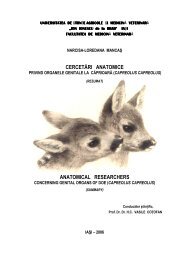
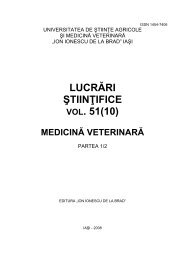

![rezumat teză [RO]](https://img.yumpu.com/19764796/1/190x245/rezumat-teza-ro.jpg?quality=85)
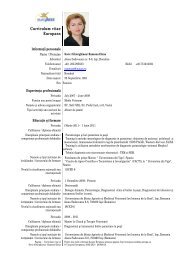



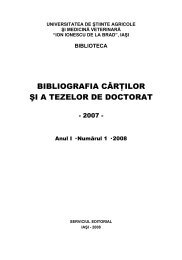
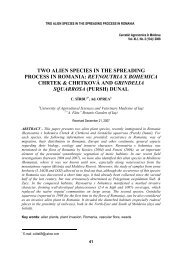
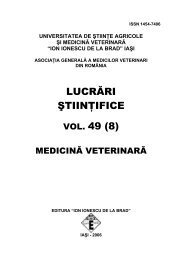
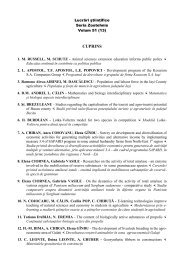

![rezumat teză [RO] - Ion Ionescu de la Brad](https://img.yumpu.com/14613555/1/184x260/rezumat-teza-ro-ion-ionescu-de-la-brad.jpg?quality=85)
